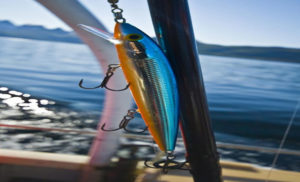
As you may already know, trolling with lures and baits is perhaps the best technique to tease, attract and catch big game fish, but what many novice anglers don’t know is the fact that your trolling speed and bait position can make a big different in terms of your success rate.
Therefore, it is important to develop a good understanding about:
- How far behind the yacht should you position your baits?
- How fast to troll?
Bait Position
Generally, the positioning of your bait should be anywhere from 20ft to 150ft of your yacht. However, it is important to understand that not all yachts or boats are the same so you need to adjust the position of your bait according to the sea conditions and the type of wake that your yacht produces. For this, start by placing your bait close to the transom (the surface that forms the stern), and then gradually move it back, as you see what it looks like and the results that you get with the bait placed at different distances.
Also, setup the spread in a staggered pattern as it makes it look bigger. Another tip is to position your bait in clean areas as it gives the game fish a clear view of the spread. Clean areas are those places in the wake where the sea water is not disturbed due to air bubbles.
Maintaining the Right Trolling Speed
Maintaining the right trolling speed is equally important. Though there is no single speed that you can rely on, the best way to maintain and control the trolling speed is to observe the lures. The idea is to make your lures and baits work together as one unit. You need to make your lures troll fast enough to create air-pockets in front of them, giving a bubbling appearance.
Generally, the best trolling speed varies from 6 knots to 12 knots. However, to get the speed right every time, log the sea conditions, rpm, speed, positions and the size, type, weight and shape of the lures. The size and type of the lures can help you determine the speed of trolling. Some lures are created for rough water conditions while others are made for calm waters.
Also, another factor to keep in mind is the specie that you’re fishing for. Some marine species respond to slow presentations while others like fast trolling speeds.
